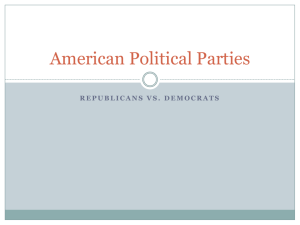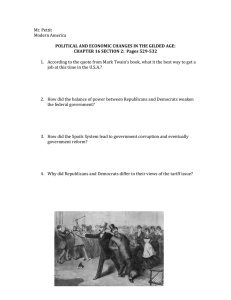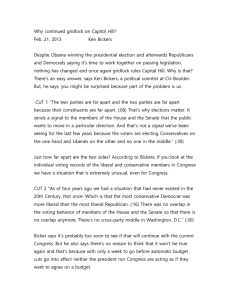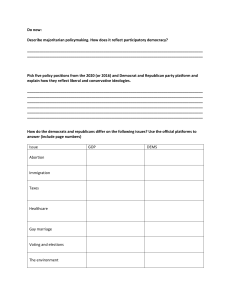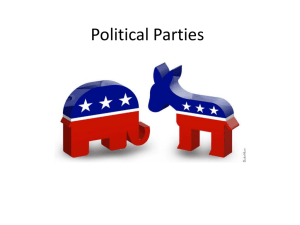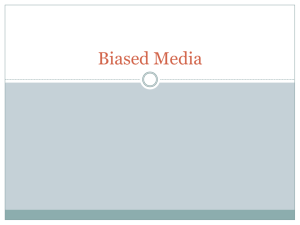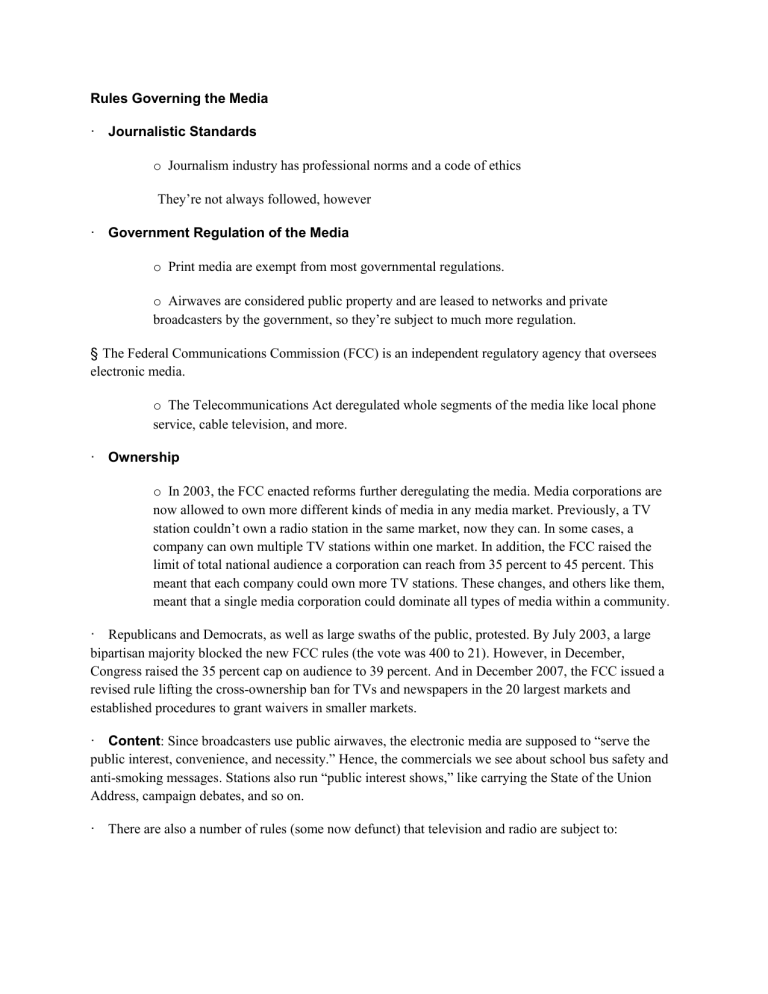
Rules Governing the Media · Journalistic Standards o Journalism industry has professional norms and a code of ethics They’re not always followed, however · Government Regulation of the Media o Print media are exempt from most governmental regulations. o Airwaves are considered public property and are leased to networks and private broadcasters by the government, so they’re subject to much more regulation. § The Federal Communications Commission (FCC) is an independent regulatory agency that oversees electronic media. o The Telecommunications Act deregulated whole segments of the media like local phone service, cable television, and more. · Ownership o In 2003, the FCC enacted reforms further deregulating the media. Media corporations are now allowed to own more different kinds of media in any media market. Previously, a TV station couldn’t own a radio station in the same market, now they can. In some cases, a company can own multiple TV stations within one market. In addition, the FCC raised the limit of total national audience a corporation can reach from 35 percent to 45 percent. This meant that each company could own more TV stations. These changes, and others like them, meant that a single media corporation could dominate all types of media within a community. · Republicans and Democrats, as well as large swaths of the public, protested. By July 2003, a large bipartisan majority blocked the new FCC rules (the vote was 400 to 21). However, in December, Congress raised the 35 percent cap on audience to 39 percent. And in December 2007, the FCC issued a revised rule lifting the cross-ownership ban for TVs and newspapers in the 20 largest markets and established procedures to grant waivers in smaller markets. · Content: Since broadcasters use public airwaves, the electronic media are supposed to “serve the public interest, convenience, and necessity.” Hence, the commercials we see about school bus safety and anti-smoking messages. Stations also run “public interest shows,” like carrying the State of the Union Address, campaign debates, and so on. · There are also a number of rules (some now defunct) that television and radio are subject to: · x Equal Time Rule: This rule requires that IF a station sells time for campaigns, they must sell it equally to all candidates. An exception is made for political debates where minor party candidates may be excluded. · x Right-of-rebuttal: This requires that a person who is attacked be offered the opportunity to respond; this was abolished in 2000. · x Fairness Doctrine (now defunct—1949–85): This required broadcasters to be fair in coverage of news events and present contrasting views. · How the Media Cover Politics · For our purposes, we are primarily interested in how media cover government. Let’s look at how the press covers each branch of government and how the tenor of coverage has changed since Watergate. · How the Press and Public Figures Interact · The communication between public officials and the media occur through both official and unofficial means. Officials use press releases, press briefings and press conferences. · Covering the Presidency · The president receives the most news coverage of any political figure. Presidents hold press conferences to shape public opinion and explain their actions. Today, a press secretary often briefs the media on a regular basis, instead of having regular press conferences with the · � · Copyright © 2011, 2009, 2007 Pearson Education, Inc. All rights reserved. 6 · · president personally. Many scholars feel that the president does get a lot of attention, but most of it is negative. Negative coverage encourages cynicism in the population at large and alienates people from politics. · The media encountered challenges in covering George W. Bush’s administration. President Bush prided himself on the “tightlipped, no leaks nature” of his White House. No one from the administration appeared in the media without prior approval, and no one talked about what went on behind closed doors. The administration was happy and the media were unhappy, but the effect on the public, and whether this is good or bad for the public, remains to be seen. · George W. Bush gave fewer press conferences than any previous president. Gerald Ford, who served only two years, gave 39, twice as many as Bush, who favored staged events in which he answered no questions. · Covering Congress · Coverage of Congress is different. Congress has 535 members and is quite decentralized. Not everyone knows each member of Congress. The committee system is unfamiliar and confusing to many citizens. Given these problems, the media tend to focus their coverage on the leadership—the Speaker and majority and minority leaders. Key committee chairs may also get some attention and local stations and papers cover local favorite sons and daughters. · The media also tend to cover congressional investigations, of which there seem to be an ever-growing number. From McCarthy in the 1950s to Watergate in the 1970s to Iran-Contra and the various Clintongates, we get first row seats to some incredible dirty laundry and a lot of partisan rhetoric. Again, most of the coverage is negative, focusing on conflicts among members or parties or conflicts between the president and the Congress. This negative coverage is probably at least partly responsible for the public’s negative perceptions of Congress. · Coverage of Congress has also greatly expanded, thanks to C-SPAN and C-SPAN2 that show gavelto-gavel coverage of the legislature. · Covering the Courts · The courts receive little media coverage. This is partly because many judicial deliberations and decision making are conducted in private. Court TV and expanded coverage of hot topics in front of the Supreme Court are slowly changing the amount of media coverage the courts receive. · Toward Reform: News Media Influence, News Media Bias and Public Confidence · News Media Influence · Most of the time, media coverage has little effect on what people think or believe. Most of us seem to selectively tune out things with which we don’t agree. However, on issues on which people don’t already have strong opinions, there is room for media influence. Media can have an impact on the uncommitted and can also affect our opinions about things that are far away from our personal experience. Media impact is increased on issues about which we know little and can also set the agenda and move some issues up, in terms of how important we think they are. Media can also frame issues. By framing, we mean they provide context and define the ways in which we think about issues. The example in the book about the KKK is a good one. · � · Copyright © 2011, 2009, 2007 Pearson Education, Inc. All rights reserved. 7 · · Lastly, the media can affect the way the public views government and politicians (perhaps even more than that: racial/ethnic/religious groups for example). Negative coverage, or negative images, can have a lasting effect. · News Media Bias · Are the news media biased? Of course they are! But how? Journalists are people with preferences, attitudes, and values just like us. Many journalists lean to the left, and many talk radio commentators lean to the right. Do their biases and political preferences affect their reporting? Sometimes. But good, responsible journalists will give all sides of a story and be objective, despite their personal biases. · Studies have shown that on some issues, there is a routine liberal bias. Abortion is one example in which studies have shown a clear preference among major media outlets on the pro- choice side/liberal side of the debate (though this might not be “bias” it may just be in line with majority opinion on this issue). And there are also conservatively biased networks like Fox News. Three of Fox News’ biggest news shows feature conservative hosts: Sean Hannity, Bill O’Reilly, and Brit Hume. And AM talk radio is definitely of a conservative bent. · It is not that simple, however. There is not only one set of biases in journalism— liberal/conservative. There are many sources of bias. The media love to create controversy and make horse races out of campaigns (focus on winners/losers). Reporters favor some politicians and give them good coverage, and dislike others and give them poor coverage. TV has biases in favor of good images and pictures. Many media outlets are now owned by huge corporations who want profit...that’s a bias, isn’t it? · Narrowcasting also favors forms of bias. If a program was designed to target a certain subset of the broader audience, it would do so. There are many other channels from which to choose if you disagree. · The best way to look at media bias is to decide for yourself, using evidence. Read widely. Watch different news outlets. Check out a variety of sources on the Internet. · Public Confidence · Americans have generally been unfavorable toward the media since the 1980s. In 2007, a Pew study showed that 55 percent of respondents thought the media were biased and 53 percent thought they were inaccurate. Republicans generally see the media as more biased than Democrats. In addition, Democrats and Republicans get their news from different sources. Republicans are twice as likely to watch FoxNews. Around 40 percent of Democrats watch network news but only 20 percent of Republicans do. Many Democrats choose CNN on cable. Democrats listen to NPR radio and Republicans listen to AM talk radio. · This ideological fragmentation could be problematic.And yet Americans believe the media is important to serve as a watchdog on government.
